

Medieval Religion. Geography and ethnic geography of the Balkans to 1500. Twenty-Five Lectures on Modern Balkan History Lecture 1: Geography and ethnic geography of the Balkans to 1500 One can't understand the Balkans without understanding its ethnic groups, and one can't understand the ethnic groups and their history without knowing the influence of the region's geography.
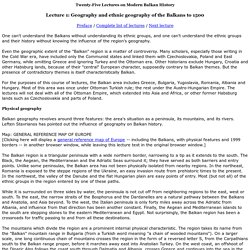
Even the geographic extent of the "Balkan" region is a matter of controversy. Many scholars, especially those writing in the Cold War era, have included only the Communist states and linked them with Czechoslovakia, Poland and East Germany, while omitting Greece and ignoring Turkey and the Ottoman era. Other historians exclude Hungary, Croatia and other Habsburg lands, because of their "central" European character, supposedly contrary to Balkan themes. History - Ancient History in depth: Peoples of Britain. Medieval History, Castles. MedievalPlus.com The Middle Ages is a period in European history which, along with its adjective ‘Medieval’, was first referred to by italian scholars and academics of the late fifteenth century.
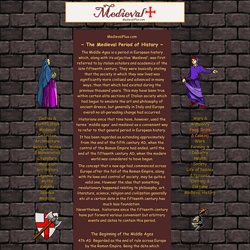
They were basically stating that the society in which they now lived was significantly more civilized and advanced in many ways, than that which had existed during the previous thousand years. This may have been true within certain elite sections of Italian society which had begun to emulate the art and philosophy of ancient Greece, but generally in Italy and Europe overall no all-pervading change had occurred. Historians since that time have, however, used the terms 'middle ages' and medieval as a convenient way to refer to that general period in European history. Courtly Love - World History in Context. One of the most commonly held, and perhaps most misunderstood, modern notions about the Middle Ages is the type of romantic or erotic love believed to have been practiced in the period, popularly referred to as "courtly love.

" Courtly love is a cluster of related ideas and sensibilities characterizing an extreme expression of romantic passion that was demonstrated frequently by characters in medieval literature, especially in courtly romances and the love lyrics of the French troubadours and the German minnesingers. The term "courtly love" was never used in medieval texts, although medieval authors and poets did use the term fin'amors (refined love) to describe the extremes of emotion experienced, often suffered, by male protagonists in romances and by the lover singing love songs to his beloved in the lyric tradition. The Main Characteristics of Courtly Love. Courtly Love Main characteristics: 1.
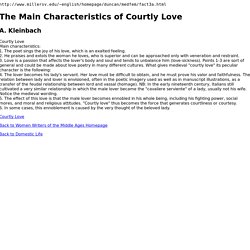
The poet sings the joy of his love, which is an exalted feeling. 2. He praises and extols the woman he loves, who is superior and can be approached only with veneration and restraint. 3. Love is a passion that affects the lover's body and soul and tends to unbalance him (love-sickness). Points 1-3 are sort of general and could be made about love poetry in many different cultures. What gives medieval "courtly love" its peculiar character is the following: 4.
Courtly Love Back to Women Writers of the Middle Ages Homepage Back to Domestic Life. A Code of Chivalry. Courtly Love - World History in Context. One of the most commonly held, and perhaps most misunderstood, modern notions about the Middle Ages is the type of romantic or erotic love believed to have been practiced in the period, popularly referred to as "courtly love.
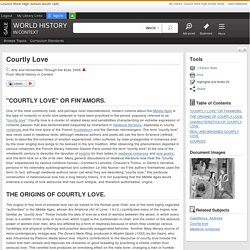
" Courtly love is a cluster of related ideas and sensibilities characterizing an extreme expression of romantic passion that was demonstrated frequently by characters in medieval literature, especially in courtly romances and the love lyrics of the French troubadours and the German minnesingers. The term "courtly love" was never used in medieval texts, although medieval authors and poets did use the term fin'amors (refined love) to describe the extremes of emotion experienced, often suffered, by male protagonists in romances and by the lover singing love songs to his beloved in the lyric tradition.
But what exactly was the late medieval European phenomenon known popularly as "courtly love"? The knights and ladies at the aristocratic courts. A. E. W. J. The Main Characteristics of Courtly Love. History - Thomas Becket. Archbishop of Canterbury. Alternative titles: Thomas à Becket; Thomas of London Becket, Saint Thomas: Murder of Thomas BecketBy permission of the British Library Saint Thomas Becket, also called Thomas À Becket, or Thomas Of London (born c. 1118, Cheapside, London—died December 29, 1170, Canterbury, Kent, England; canonized 1173; feast day December 29), chancellor of England (1155–62) and archbishop of Canterbury (1162–70) during the reign of King Henry II.
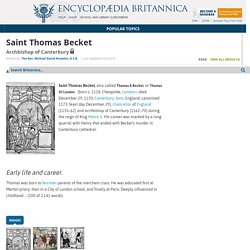
His career was marked by a long quarrel with Henry that ended with Becket’s murder in Canterbury cathedral. Thomas was born to Norman parents of the merchant class. St. Thomas Becket - Archbishop, Saint - Biography.com. Geoffrey Chaucer. Geoffrey Chaucer was born in London sometime between 1340 and 1344 to John Chaucer and Agnes Copton.
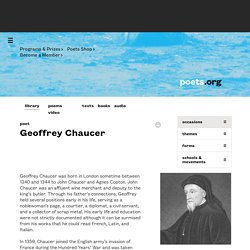
John Chaucer was an affluent wine merchant and deputy to the king’s butler. Through his father’s connections, Geoffrey held several positions early in his life, serving as a noblewoman’s page, a courtier, a diplomat, a civil servant, and a collector of scrap metal. His early life and education were not strictly documented although it can be surmised from his works that he could read French, Latin, and Italian. In 1359, Chaucer joined the English army’s invasion of France during the Hundred Years’ War and was taken prisoner; King Edward III of England paid his ransom in 1360.
In 1366, Chaucer married Philipa de Roet, who was a lady-in-waiting to Edward III’s wife. Chaucer’s early work is heavily influenced by love poetry of the French tradition, including the Romaunt of the Rose (c. 1370) and Saint Cecilia (c. 1373), later used as the “Second Nun’s Tale” in the Canterbury Tales. The Life of Geoffrey Chaucer (c. 1343-1400) [Chaucer Biography] GEOFFREY CHAUCER, English poet.
![The Life of Geoffrey Chaucer (c. 1343-1400) [Chaucer Biography]](http://cdn.pearltrees.com/s/pic/th/geoffrey-chaucer-biography-18728798)
The name Chaucer, a French form of the Latin calcearius, a shoemaker, is found in London and the eastern counties as early as the second half of the 13th century. Some of the London Chaucers lived in Cordwainer Street, in the shoemakers' quarter; several of them, however, were vintners, and among others the poet's father John, and probably also his grandfather Robert. Legal pleadings inform us that in December 1324 John Chaucer was not much over twelve years old, and that he was still unmarried in 1328, the year which used to be considered that of Geoffrey's birth. The poet was probably born from eight to twelve years later, since in 1386, when giving evidence in Sir Richard le Scrope's suit against Sir Robert Grosvenor as to the right to bear certain arms, he was set down as "del age de xl ans et plus, armeez par xxvij ans. " In the second quarter of 1374 Chaucer lived in a whirl of prosperity.
In February 1394 he was granted a new pension of £20. (A. History - Geoffrey Chaucer. Geoffrey Chaucer - Author, Poet - Biography.com. English poet Geoffrey Chaucer wrote the unfinished work, The Canterbury Tales.
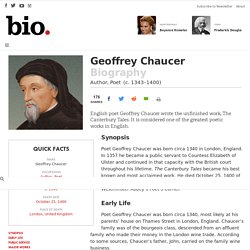
It is considered one of the greatest poetic works in English. Synopsis Poet Geoffrey Chaucer was born circa 1340 in London, England. In 1357 he became a public servant to Countess Elizabeth of Ulster and continued in that capacity with the British court throughout his lifetime. The Canterbury Tales became his best known and most acclaimed work. Early Life Poet Geoffrey Chaucer was born circa 1340, most likely at his parents’ house on Thames Street in London, England. Geoffrey Chaucer is believed to have attended the St. In 1357, Chaucer became a public servant to Countess Elizabeth of Ulster, the Duke of Clarence’s wife, for which he was paid a small stipend—enough to pay for his food and clothing.